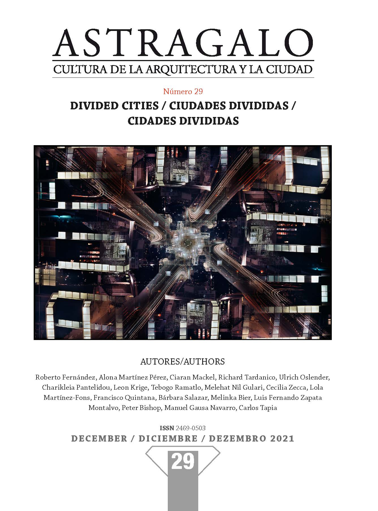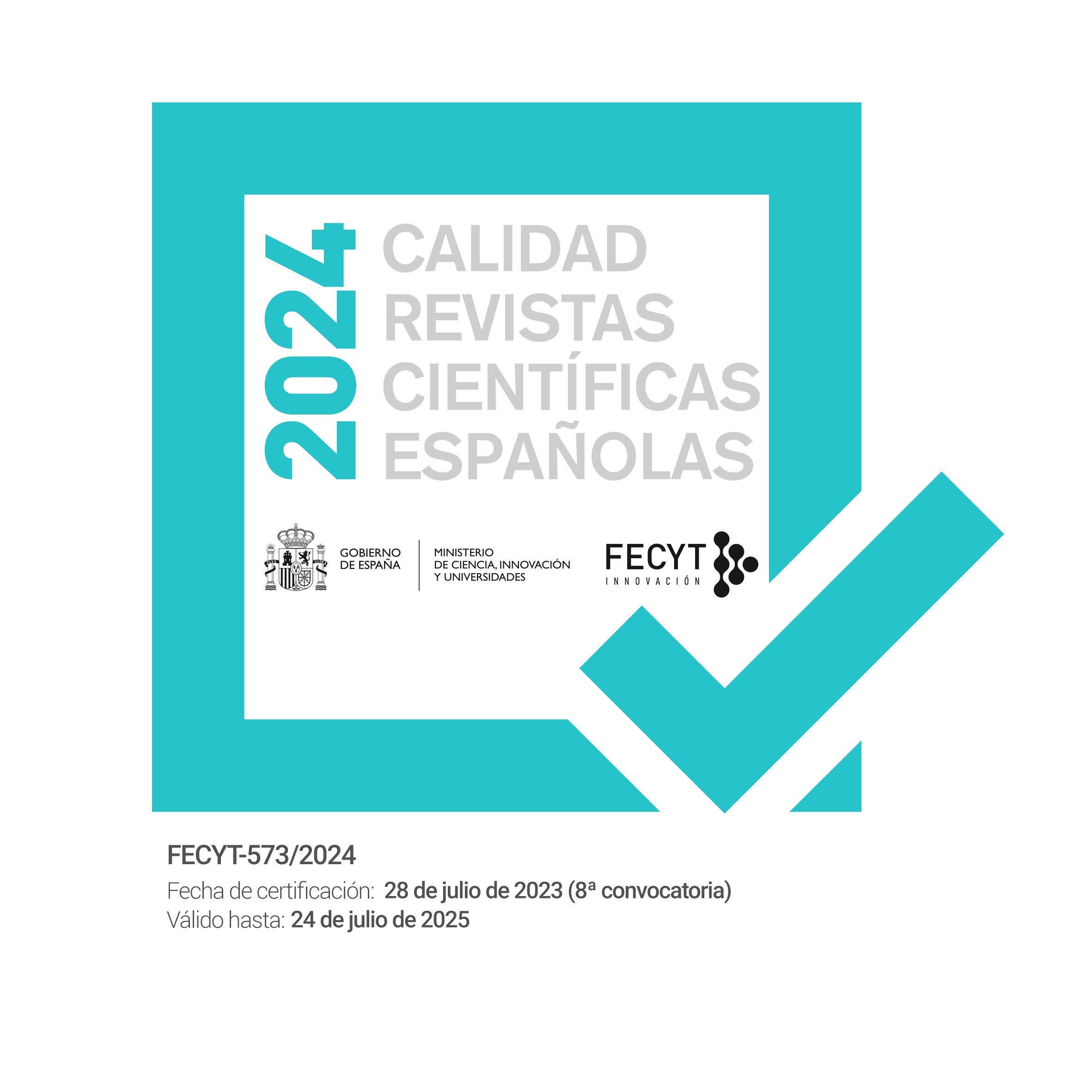Entre los territorios disputados y la reapropiación espontánea: Nicosia dividida
DOI:
https://doi.org/10.12795/astragalo.2021.i29.09Palabras clave:
memoria colectiva, ciudades disputadas, identidad urbana, urbanismo inclusivo, disputa de ChipreResumen
Este artículo analiza los conceptos de conflicto y frontera en relación con el lugar y la identidad, reflexionando sobre las narrativas y los significados de las fronteras urbanas y civiles divididas. Toma como caso de estudio la sociedad griega y turca dividida que vive en Nicosia. El significado del muro, como expresión explícita de la división, se discute, pero también se revierte, al observar su cierre y su permeabilidad cuando las fronteras selladas de Nicosia se abrieron de nuevo para el cruce cotidiano.
La investigación especula con un camino alternativo basado en el concepto de opacidad de Glissant y en los enfoques no esencialistas de Agamben y Nancy, la no comunidad, para examinar las divisiones étnicas profundamente arraigadas y los fragmentos de culturas compartidas. Para fundamentar la epistemología urbana, se analizan dos ejemplos ascendentes utilizando los conceptos de vida cotidiana de De Certeau: el Hogar para la Cooperación, que es un espacio neutro en la zona de amortiguación para unificar colectivamente, y el Movimiento Occupy Buffer-zone, que ha ocupado un no-lugar y lo ha transformado en una plaza pública mediante el activismo de base.
El documento destaca que para dibujar un futuro factible de Chipre es necesario aceptar de forma antiesencialista los orígenes múltiples y eclécticos del contexto. En este sentido, el significado tangible e intangible de la división requiere un cambio de significado, desde la delimitación, la clasificación y la separación hasta un elemento poroso de equilibrio y calibración. Los modelos urbanos de arriba abajo y el concepto de inclusividad se han visto sacudidos por las comunidades cívicas temporales de base, y esto demuestra que la participación colectiva fomenta la reapropiación del espacio público, trastocando la percepción y la experiencia de la frontera de las diferencias. Esto contribuye a teorizar una práctica crítica y reflexiva, más que idealista, de la participación en el diseño urbano.
Descargas
Citas
Agamben, Giorgio. 1993. The Coming Community. Minneapolis: University of Minnesota Press.
Brand, Ralf. 2009. “Written and Unwritten Building Conventions in a Contested City: The Case of Belfast”. Urban Studies. 46, 12: 2669–2689.
Bollens, Scott A. 2012. City and Soul in Divided Societies. London: Routledge.
Cacciari, Massimo. 2004 La cittá. Villa Verrucchio: Pazzini Editore.
Calderon, Camilo. 2020. “Unearthing the political: differences, conflicts and power in participatory urban design”. Journal of Urban Design 25, 1: 50-64.
Carmona, Matthew. 2014. “The Place-shaping Continuum: A Theory of Urban Design Process.” Journal of Urban Design. 19, 1: 2-36.
Cuthbert, Alexander R. 2007. “Urban Design: Requiem for an Era - Review and Critique of the Last 50 Years.” Urban Design International 12 (4): 177–223.
De Certeau, Michel. 1998. The Practice of Everyday Life: Living and cooking. London: University of California Press. Translated by Steven Rendell.
De Vita, Gabriella E., Claudia Trillo and Alona Martinez-Perez. 2016. “Community planning and urban design in contested places. Some insights from Belfast”. Journal of Urban Design, 21:3, 320-334, DOI: 10.1080/13574809.2016.1167586
Dikomitis, Lisa. 2005. “Three readings of a border”. Anthropology Today 21, 5: 7-12.
Hirsch, Marianne. 2001. “Surviving Images: Holocaust Photographs and the Work of Postmemory”. The Yale Journal of Criticism 14, 1: 5-37.
Gaffikin, Frank, Malachy Mceldowney and Ken Sterrett. 2010. “Creating Shared Public Space in the Contested City: The Role of Urban Design. Journal of Urban Design 15 (4): 493–513. DOI: 10.1080/13574809.2010.502338
Gheerawo, Rama. 2016. “Socially inclusive design: A people-centred perspective”. Companion to Design Studies, edited by Penny Sparke and Fiona Fisher, 304-316. London: Routledge.
Glissant, Édouard. 1997. Poetics of Relation. Translated by Betsy Wing. Ann Arbor: University of Michigan Press.
Glissant, Édouard. 2020. Introduction to a Poetics of Diversity. Translated by Celia Britton. Available online: http://public.eblib.com/choice/PublicFullRecord.aspx?p=6230108 (accessed on 15 December 2021).
Goker, Ayse A. 2007. “Being 'Cypriot' in North London: strategies, experiences and contestations”. PhD Thesis, University College London, Department of Anthropology.
Gulari, Melehat N., Asli Börü and Julian Malins. 2011. “Towards an evolutionary understanding on the success of participatory design”. 2011 Design Education for Creativity and Business Innovation Conference edited by Ahmed Kovacevic, William Ion, Chris McMahon,
Lyndon Buck, and Peter Hogarth, 721-726, London, UK.
Hou, Jeffrey, Benjamin Spencer, Thaisa Way and Ken Yoco. 2015. Now Urbanisms. The future City is here. London: Rutledge.
Iliopoulou, Eirini and Pafsanias Karathanasis. 2014. “Towards a Radical Politics: Grassroots Urban Activism in the Walled City of Nicosia”. The Cyprus Review 26, 1: 169-192.
Jones, Reece. 2012. “Spaces of refusal: rethinking sovereign power and resistance at the border”. Annals of the Association of American Geographers 102, 3:685-699. https://doi.org/10.1080/00045608.2011.600193
Karahasan, Hakan. 2005. “Different narratives, different stories: the language of narrative and interpretation”. Journal of Cyprus Studies, 11 28-29: 115-128.
Kliot, Nurit and Yoel Mansfeld. 1997. “The political landscape of partition: The case of Cyprus”. Political Geography 16, 6: 495-521.
Mallinson, William. 2016. Kissinger and the Invasion of Cyprus: Diplomacy in the Eastern Mediterranean. New Castle Upon Tyne: Cambridge Scholars Publishing.
Mouffe, Chantal. 2005. On the Political - Thinking in Action. Abingdon: Routledge.
Nancy, Jean-Luc. 1991. Inoperative Community, Minneapolis, MN: University of Minnesota Press.
Papa, Venetia and Peter Dahlgren. 2017. The Cypriot ‘Occupy the Buffer Zone’ movement: online discursive frames and civic engagement. Oxford: Berghan books.
Peck, Jamie. 2015. “Cities Beyond Compare?” Regional Studies: The Journal of the Regional Studies Association 49, 1–2: 160–182. doi: 10.1080/00343404.2014.980801
Pullan, Wendy and Britt Baillie. 2013.. Locating Urban Conflicts – Ethnicity. Nationalism and the Everyday. London: Palgrave Macmillan.
Relph, Edward. 1976. Place and placelessness. London:Pion.
Rogers, R., 2017. A place for all people: Life, Architecture and the Fair Society.Edinburgh; London: Canongate Books Limited.
Tagliacollo, Emma. 2011. “I confine di Cipro: il “muro” di Nicosia”. Richerche di S/Confine, vol. II, n.1. Available on https://www.repository.unipr.it/bitstream/1889/1546/1/TAGLIACOLLO-confini.pdf Last accessed 15 December 2021.
Webster, Craig. and Timothy, Dallen J. 2006. “Travelling to the ‘Other Side’: the Occupied Zone and Greek Cypriot Views of Crossing the Green Line”. Tourism Geographies, 8 (2): 162-181.
Descargas
Publicado
Cómo citar
Número
Sección
Licencia
Derechos de autor 2021 Melehat Nil Gülari, Cecilia Zecca

Esta obra está bajo una licencia internacional Creative Commons Atribución-NoComercial-CompartirIgual 4.0.


















